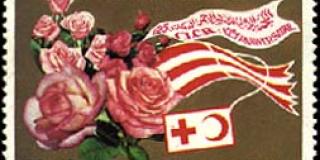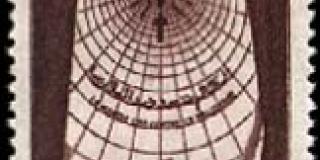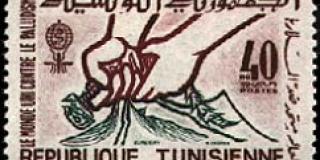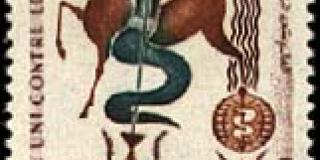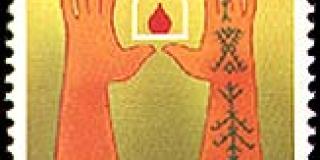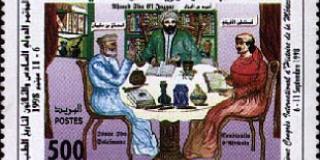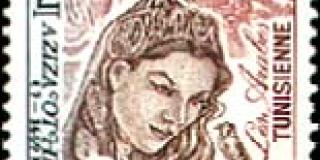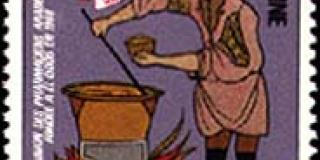The Contribution of Artists in Spreading Health Culture: Postage Stamps in Tunisia (1958–2023)
Curated by Professors Lilia Labidi and Taoufik Nacef
Tunisia, a North African country, has been a land of many cultures (Capsian, Amazigh/Berber, Punic, Roman, Byzantine, Arabo-Muslim and European) which marked the imaginations of its artists. The Tunisian Postal Museum allows the visitor to see the history of philately and postal collecting in Tunisia, informs visitors about the country’s political culture and provides insights into the country's art history as well as into the imagination of artists and the aesthetics developed through the works created for the Post Office. While the first Tunisian postage stamp dates from 1888, this exhibition focus on a corpus of 44 stamps produced between 1958 and 2023 on the theme of medicine, health and medical personalities, aiming to encourage the spread of health culture to a wider population. The stamps were designed by 20 artists (13 men and 7 women), with four stamps made by anonymous artists.
- Contribution of Tunisian artists to the spread of health culture between 1958 and 2023
The artists who created the stamps in this corpus belong to three generations. The first group includes artists such as Hatem El Mekki and those who were part of L’Ecole de Tunis (the Tunis School), such as Ali Bellagha and Abdelaziz Gorgi, all born between 1918 and 1928. They also taught in the university, worked in their own studios, and Bellagha and Gorgi had their own galleries. These three artists produced a total of 20 stamps in this corpus, the majority by Hatem ElMekki, who created 14 stamps.
The next group, made up of artists from the second generation, is composed of Amor Ben Mahmoud(b.1938), Tijani Ellouze(b.1941), Abdelmajid Ayed(b.1946), Moncef Mansi(b.1949) and Aicha Filali(b.1956). Mohammed Sammoud (also written Samoud) whose exact date of birth we have not been able to find, also belongs to this group. Most produced a single stamp, with only Mohammed Sammoud producing more(three stamps). The third group includes twelve artists—six women (Insaf GuezGuez Jellazi, Sonia Chahata, Zeinab Krima, Souhir Charfi, Islam Ouali, and Lamia Boukhris) and five men (Hachem Boughattas, Ahmed Fekih, Ali Fakhet, Tahar Ben Dkhil, and Yassine Ghorbel). Some among this group are design teacher-researchers. Most in this last group produced one stamp, with only Souhir Charfi producing two stamps, in 2015.
- The role of stamps in encouraging different stakeholders to raise health awareness among the general public
Analysis of the corpus of 44 stamps shows that the works of first generation of artists provided considerable support for campaigns to promote health with the World Health Organization (WHO), with civil society associations, and with those undertaken by the State.
- Campaigns with World Health Organization (WHO)
In coordination with the WHO, three stamps were created by three artists and issued for the global campaign in 1962 for the eradication of malaria. Each stamp has malaria icons that are recognized worldwide. These three stamps, in different styles, all convey the same message about the global campaign to eradicate malaria. Bernard Brabin, who reviewed the literature that examined the philathelic program that helped to generate international commitment to the goal of malaria eradication in 1962, notes that “Nonetheless postage stamps greatly helped to communicate the importance of malaria control programs to a wide audience and to some extent, have supported preventive health messages.”
- Civil society campaigns
The 1980s were the period when iconography highlighted actions carried out by civil society such as The Red Crescent, The Red Cross or the Tunisian Association of Blood Donors (ATDS), broadening their appeal for attention to health issues.
Aicha Filali, an artist known for her conceptual works, here calls on Tunisians, urban and rural, with the rural population designated by the tattoo on the arm, to mobilize for blood donation. Ahmadreza Afshar and Neda Afshar report that in Iran the hand is often used on postage stamps to promote health programs and policies and they discuss how the “images of hands have been used to present different medical subjects to the public.”
- Using art to raise the general public’s awareness of acute health issues
From the 1980s on, artists popularized, via postage stamps, important health issues such as tuberculosis, protection against radiation, organ donation, the importance of veterinary controls for food safety, breast cancer, the fight against covid-19, information on autism, etc. In terms of gender, the first woman artist is Aicha Filali, who contributed to this corpus in 1981. All the other women artists emerged starting in 1999. In this category, we can see the work of Islem Ouali, which deals with breast cancer.
The stamp by Islem Ouali, produced in 2022, is very important as the first to show a woman’s naked body in Tunisia on a widely seen medium like a postage stamp. The woman artist, Islem Ouali, by showing the arms on the woman's chest, conveys the shame for women suffering from cancer of losing a breast, their regret at not having protected themselves sooner. The pink ribbon covering the woman’s stomach to her hips symbolizes the information campaign for early diagnosis and treatment. All we see of the woman is the silhouette of her body; of her head we see only her chin, as her head is hidden in a cloud of anxiety. This stamp is innovative and breaks with traditional representations.
- Campaigns with World Health Organization (WHO)
- The postage stamp for highlighting illustrious medical figures and medical societies
Our corpus includes stamps representing men and women who deserved to be elevated to the rank of illustrious personalities by the Tunisian State.
- Male figures in medicine
The first postage stamp issued in 1958 on the occasion of the universal and international exhibition held in Brussels, the value of which is mentioned in francs (30 Francs), represents two illustrious historical figures—the anatomist André Versal(1514-1564, Belgian) and Ibn Khaldoun (1332–1406), the legendary Tunisian sociologist. The name of the designer is not known.
Another stamp, from 1998, represents three historical figures and was produced by Ahmed Fekih. A horizontal work, worth 500 millimes, it shows three men seated around a table. On the left of the stamp, we see Ishaq Ben Salomon al-Israeli, a Jewish doctor and philosopher born in Egypt who practiced in Kairouan, in Tunisia. He was also the professor of Ahmed Ibn AlJazzar, a Tunisian doctor born in Kairouan(who livd from 878-980), who we see in a green outfit, seated in the center of the stamp. Ibn AlJazzar was the author of more than 40 works on medicine which were translated into Greek, Latin and Hebrew and were thus introduced into Europe where they were used for teaching in the medical universities in Europe. To the right of the table we see Leo the African, dressed in red, who translated several works of Arabic medicine, including those of Ibn AlJazzar, into Latin. This stamp was issued on the occasion of the 36th International Congress on the History of Medicine held in Tunis in 1998.
Other stamps are dedicated to Avicenna, Iranian doctor, on the occasion of his millennium; to the professor Hulusi Behcet, Turkish; and to Ibn Rushd (Averroes) from Cordoba on the occasion of the 800th anniversary of his death. All were made by the artist Hatem El Mekki. A stamp dedicated to the Tunisian doctor Ibn AlJazzar is the work of Ali Bellagha. The last stamp in this group, dedicated to Mongi Ben Hamida(1928-2003), a professor of medicine at the Faculty of Medicine of Tunis, was produced by Zaineb Krima, the only female artist to have illustrated a stamp to honor a medical figure.
- Stamps dedicated to famous women in the field of health in Tunisia
Five stamps are dedicated to women. Unlike the men, all the women in this series are Tunisian. Only two stamps were made by well-known artists. The first in this series is dedicated to Princess Aziza Othmana, a patron who donated her wealth to care for hospital patients. The stamp, issued in 1985, has a value of 500 millimes and is the work of Hatem ElMekki. This was issued during a decade dominated by feminist debates throughout Tunisian society. The second stamp is dedicated to Tawhida Ben Cheikh, the first Tunisian Muslim woman to graduate in 1936 from the Faculty of Medicine in Paris. It was released in 2012 and designed by Tahar Ben Dkhil. The other three stamps celebrate women doctors who were professors at the Tunis Faculty of Medicine: Dr Habiba Jilani, first female surgeon; Dr Azza Hammou, a radiologist highly valued for her teaching and her interpretations of x-ray data; and Dr Ahlem BelHaj, child psychiatrist, feminist and general secretary of university hospital doctors. Their stamps show portrait photographs, taken by anonymous artists. They were issued in 2023 by the Ministry of Family Affairs, Women, Children and the Elderly in collaboration with the Tunisian Post Office. The stamps issued in 2022 and 2023 were produced after January 2011, in the post-revolutionary context of the “Arab Spring” where women were very present on the political scene.
- Stamps issued to celebrate actions carried out in collaboration with international, continental and regional medical societies
The stamps in this section were created by artists Abdelaziz Gorgi, Amor Ben Mahmoud, Ali Bellagha, Hatem ElMekki, Mohamed Sammoud and Ahmed Fekih, issued to reflect the importance of regional, continental and international medical organizations for the circulation of knowledge.
The stamp made by Abdelaziz Gorgi in 1970, is intended to foster hope. The caregivers, represented here by a woman who holds in her hand the symbol of the medical corporation, has her hand tinted with henna, symbolizing the celebration of the 6th Maghreb Medical Day. The bracelets that cover her arm show the flags of the Maghreb countries. Vertical, with a value of 25 millimes, this stamp symbolizes the action of the medical community of Maghreb countries which acts together, as with one hand. The stamp on the right, made by Ali Bellagha, commemorates the founding of the Union of Arab Pharmacists. Vertical, with a value of 80 millimes, this stamp, whose design shows a pharmacist making potions to administer to the sick, celebrates the genius of Arab doctors who bequeathed numerous works on plant medicine.
- Male figures in medicine
Conclusion
To conclude, if the diversity of stamps issued between 1958 and 2023 by the Tunisian Post Office testifies to the health challenges that the country has faced in different periods, it also shows how Tunisian artists, men and women, of different generations, have contributed, via their works printed on stamps, to promote a culture that helps meet health challenges. This corpus of stamps issued by the Tunisian state, while transmitting the concerns specific to the State, also reflects those of international and local medical organizations, and of civil society. It also allows us to see how artists from different generations managed, without renouncing their artistic choices, to translate aesthetic perspectives according to gender and generations. Stamps have thus played a role, over these decades, as “spokespersons” for these various levels of society.
The exhibition’s curators are Lilia Labidi and Taoufik Nacef
Lilia Labidi is an anthropologist and psychologist, formerly professor at the University of Tunis, Tunisia, and has taught at universities in France, the USA, Egypt, and Singapore, and lectured in a number of countries in Europe, the Maghreb, Africa, and Asia, and is a Global Fellow at the Woodrow Wilson Center, Washington DC. She is the author of several books and numerous articles on the Arab world. She organized several documentary exhibitions on subjects that include women's movements in Tunisia, wedding photographs over three
generations in Tunisia, COVID-19 as seen by Tunisian cartoonists, Two Photographers in Dialogue with World Traveler Ibn Battuta, and installations on political violence.
Taoufik Nacef, a doctorate of the Faculty of Medicine and Pharmacy of Bordeaux, became professor at the Faculty of Medicine of Tunis in 1972 and then Head of the University Hospital Department of Pneumo-phthisiology and Director of the Department of Preventive and Social Medicine and Hygiene. He was also director of the Center for Research and Educational Training for Health Executives, Director-General of Health at the Ministry of Public Health, and member of the cabinet of the Ministry of Higher Education and Scientific Research. He is also author of several clinical and epidemiological research studies on respiratory diseases, particularly asthma (winning the Dexo Allergy Prize, 1970), and on the organization of health systems and the quality of care.
Acknowledgments
We are grateful to the Tunisian Post Office for their collaboration in this project. And we thank Olfa Mokaddem, head of the Philately Center of the Tunisian Post Office for the support provided during the preparation of this exhibition. We also want to thank Rabiaa Kaddachi, Abderrazek Ghammouri and Amor Zammouri of the Philately Center for their collaboration, the design and preparation of stamp plates of this exhibition.
*Notes to the text are with the curators. ** Contact: labidi.lilia@yahoo.com
